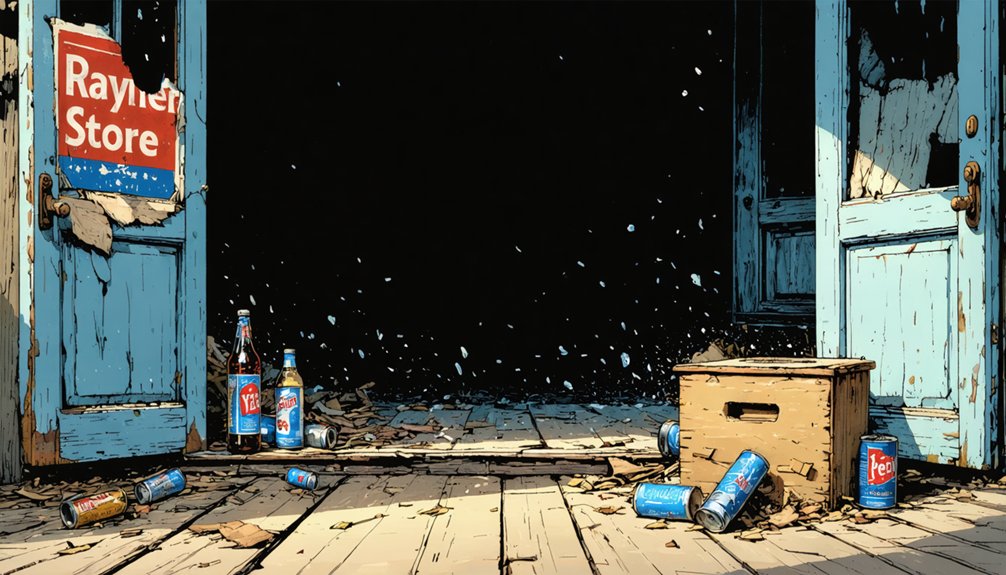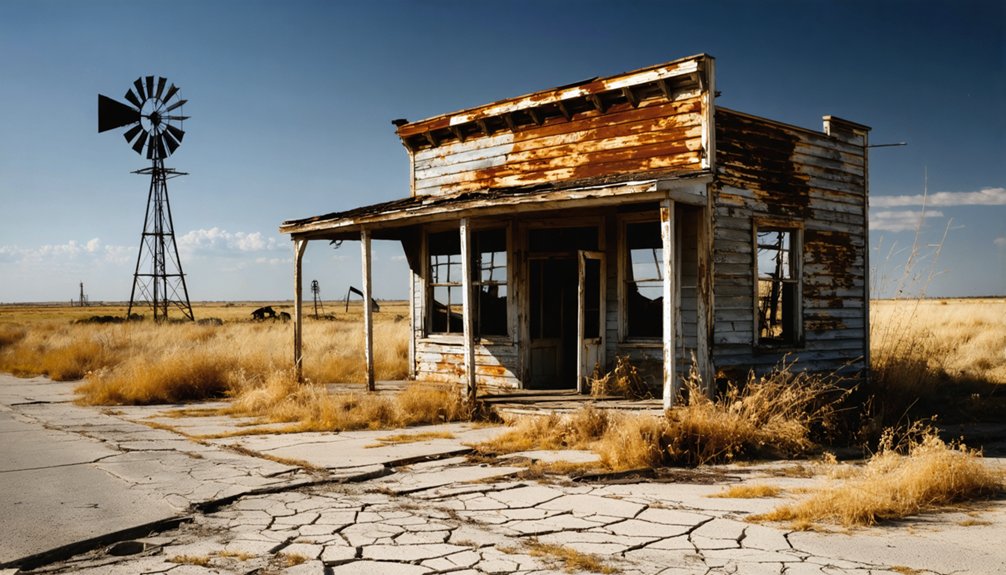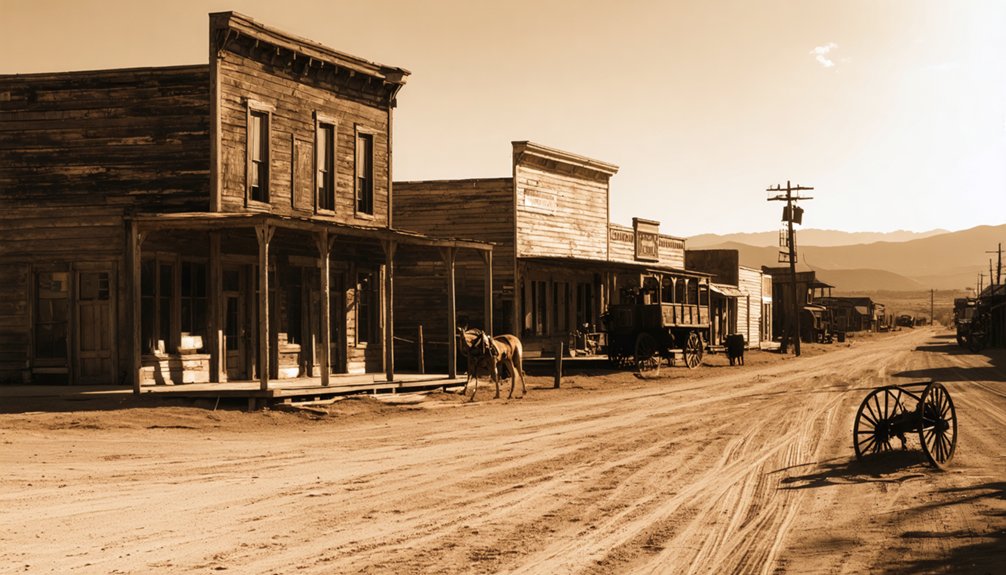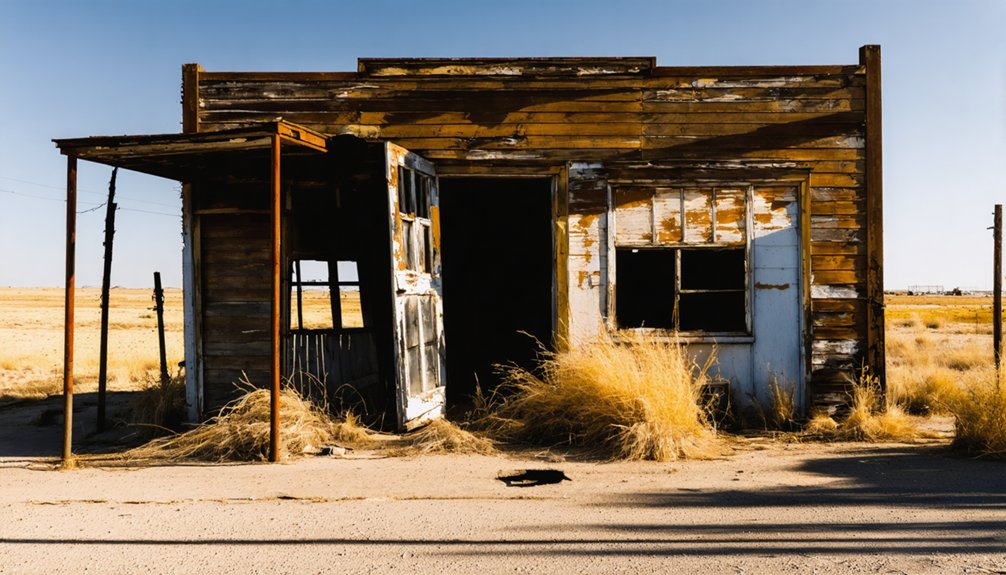You’ll find Rayner’s remains in Stonewall County, Texas, where ambitious dreams of a county seat began in 1889. Walter E. Rayner platted 63 city blocks and built a striking three-story stone courthouse, drawing 250-300 residents at its peak. Though cattle and sheep ranching sustained the town initially, Rayner lost its county seat status to Aspermont in 1898. By 1906, the post office closed, but the 1891 courthouse still stands as a silent witness to this frontier settlement’s bold aspirations.
Key Takeaways
- Rayner, Texas was founded in 1889 as Stonewall County’s first county seat, reaching a peak population of 250-300 residents.
- The town declined after losing its county seat status to Aspermont in 1898 through a contentious election.
- The historic three-story stone courthouse, built in 1891, remains standing as the town’s most significant architectural landmark.
- Rayner’s economy relied heavily on cattle and sheep ranching but failed to diversify, contributing to its eventual downfall.
- The closure of Rayner’s post office in 1906 marked the final stage of its transformation into a ghost town.
The Birth of a Frontier Town (1889)
When Walter E. Rayner platted his namesake town in June 1889, he laid the groundwork for Stonewall County‘s first organized settlement.
You’ll find his frontier aspirations reflected in the ambitious layout of 63 city blocks, with streets cutting north-south and east-west across the Texas plains.
As the designated county seat, Rayner marked a turning point for a region that had remained unorganized since the Texas legislature created Stonewall County in 1876.
Despite settlement challenges, the town soon boasted a commanding three-story stone courthouse and established an essential post office. The new community quickly developed diverse business establishments, including general stores, a photography studio, and a barber shop.
In the face of frontier hardships, Rayner’s stone courthouse rose three stories high, standing proud alongside its vital post office.
The community grew to accommodate 250-300 residents, transforming this slice of wilderness into a hub of local government and commerce.
It’s here that the foundations of formal governance in Stonewall County took root. The local rancher’s residence that once served as the courthouse still stands as a testament to those early days.
Dreams of County Seat Glory
You’ll find the heart of Rayner’s story in W.E. Rayner’s ambitious 1889 plan to establish a county seat, marked by his purchase of land for 63 city blocks and construction of an imposing three-story stone courthouse.
The town’s early promise rested heavily on securing its role as the political center of the newly formed Stonewall County, though this dream was clouded by allegations of fraud in the pivotal 1888 election. The completion of the stone courthouse building in 1890 marked a significant milestone for the growing community. The town reached its peak with a population of 250 in the early 1890s.
Your visit to Rayner today reveals how these grand political aspirations crumbled when rival Aspermont won the county seat in 1898, triggering an exodus that would transform this once-promising frontier town into a ghost town.
Courthouse Ambitions Drive Settlement
As Stonewall County took shape in 1888, Rayner’s founders staked their town’s future on becoming the seat of local government.
You’ll find the courthouse significance clearly marked by the stone building they erected in 1891, positioned 2.6 miles west on US 380 as a symbol of their determination and vision.
The settlement impact was immediate, as the courthouse’s presence attracted both settlers and businesses seeking opportunities near the county’s administrative hub. During its peak years, the town grew to include a population of 250 to 300 residents.
The stone walls weren’t just for show – they represented Rayner’s ambitions and its promise of permanence. The architectural firm of Martin, Byrne & Johnston designed the impressive courthouse structure.
Yet this dream would prove short-lived. By 1898, rival town Aspermont won the county seat designation, triggering Rayner’s decline and eventual transformation into the ghost town you’ll discover today.
Politics Shapes Town’s Birth
The political birth of Rayner intertwined deeply with Stonewall County’s creation in 1888, revealing a calculated strategy by land speculators to establish a power center in Texas’s developing frontier.
You’ll find Captain W.E. Rayner’s political maneuvering at the heart of this ambitious venture, as he orchestrated both the county’s formation and his town’s designation as its seat.
Through a controversial election on December 20, 1888, featuring an ambiguous ballot clause, Rayner secured its position as county seat despite claims of fraud.
Like many semi-abandoned towns of Texas, land speculation drove this political power play, with the town meticulously platted into 63 blocks.
The strategy culminated in the construction of a grand three-story stone courthouse in 1891, a tribute to the founders’ determination to cement Rayner’s role as the county’s administrative hub.
Speculative Dreams Turn Sour
While Captain W.A. Rayner’s vision for his namesake town was bold, his speculative ventures couldn’t overcome harsh economic challenges.
You’ll find that despite his dreams of creating a thriving county seat, Rayner’s narrow economic base – primarily cattle and sheep – left little room for sustainable growth. The town’s peak population of 250-300 residents proved fleeting once rival Aspermont emerged.
You can trace Rayner’s downfall to failed attempts at diversification. The promising copper and silver mining operations at nearby Orient fizzled out, and crop farming never took root in Rayner proper, though it flourished elsewhere in Stonewall County.
When Aspermont won the county seat in 1898, Rayner’s fate was sealed. Without political clout or economic diversity, the town couldn’t sustain itself.
The Historic 1891 Courthouse
You’ll find the imposing 1891 stone courthouse stands as a reflection of the architectural firm Martin, Byrne & Johnston’s vision, which echoed the era’s emphasis on durability and prominence in Texas government buildings.
The structure later served as someone’s private residence after Rayner lost its county seat status to Aspermont, though today it sits empty and boarded up on private land about eight miles east of town. Located along Highway 380 and CR 16, the old courthouse remains a prominent landmark in the area.
The courthouse design featured Italianate styling with its distinctive peaked roof and square tower. While the abandoned courthouse’s haunting presence nearly landed it a role in a major film production, those plans never materialized, leaving it to stand as a silent sentinel to Rayner’s ambitious past.
Architecture and Original Design
Standing as a testimony to late 19th-century Texas civic architecture, Rayner’s 1891 courthouse showcased locally quarried stone masonry and practical frontier design.
The architectural significance of this two-story rectangular structure emerged from the expertise of Martin, Byrnes, and Johnston, a firm known for their civic projects across Texas. You’ll notice the building’s rural aesthetics mirror those of the Throckmorton County Courthouse, reflecting a regional architectural language that prioritized function over ornate decoration.
The courthouse’s design embodied the spirit of Texas’s westward expansion, with its sturdy stone construction demonstrating both the county’s ambitions and practical needs.
While not lavishly adorned, the building’s professional design and prominent central entry marked it as a symbol of emerging civic authority in frontier Texas.
Private Home Conversion Story
The 1891 Stonewall County Courthouse‘s journey from civic center to private residence mirrors the broader story of Rayner’s transformation into a ghost town.
After Aspermont claimed the county seat title, this majestic stone structure faced an uncertain future until its courthouse conversion created a unique private residence.
You’ll find the building at 128 Town Square Lane, where it stands as Rayner’s most prominent reminder of its ambitious past.
While the robust stone exterior maintains its historical character, the interior underwent significant changes to accommodate residential living.
Today, the boarded-up windows and closed entrances tell the story of more recent challenges, as the building appears abandoned despite remaining under private ownership.
It’s a reflection of how Texas ghost towns often see their grand public buildings reimagined for private use.
Film Location Near Miss
Despite its commanding presence and authentic ghost town setting, the 1891 Stonewall County Courthouse has remained an elusive dream for filmmakers seeking period-perfect locations.
You’ll find this historic stone structure about eight miles east of Aspermont, standing as a symbol of Texas’s frontier era and boasting the kind of authenticity that Western film producers crave.
But don’t pack your camera gear just yet. The courthouse’s private ownership and boarded-up condition create significant location challenges for production companies.
While its architectural style and ghost town surroundings offer incredible film potential, you can’t simply show up and start shooting.
The building’s remote location, paired with access restrictions, has forced many filmmakers to seek alternative sites, leaving this piece of Texas history waiting for its moment in the spotlight.
Ranching Empire in Early Stonewall County
As buffalo hunters gradually gave way to cattle operations in the 1870s, Stonewall County’s ranching empire took root with John Goff’s pioneering establishment of 200 heifers along Tonk Creek in 1873.
You’ll find that Charles Rath’s buffalo hunters’ supply camp soon gave way to One-Armed Jim Reed’s Double Mountain Horseshoe T Cross Ranch, which introduced 3,000 longhorn cattle in 1877.
The ranching legacy expanded rapidly as settlers poured in by 1885, drawn to the vast open grasslands. The Salt Fork Brazos River provided essential water resources that sustained the growing cattle operations throughout the region.
The Battle for Political Power

You’ll find the heart of Rayner’s political turmoil in the fierce county seat election of December 20, 1888, when Captain Rayner’s ambitious vision collided with allegations of voter fraud.
The controversial election results granted Rayner the coveted position of Stonewall County seat, despite immediate protests challenging the vote’s legitimacy.
The town’s courthouse, established following official recognition in June 1889, stood as both a symbol of Rayner’s political victory and a flashpoint for ongoing power struggles in the region.
County Seat Power Struggle
When Stonewall County established Rayner as its first county seat in 1888, few could have predicted the political battle that would unfold over the next decade.
The emergence of Aspermont in 1889 sparked intense political maneuvering that would ultimately seal Rayner’s fate.
The fight for county seat power involved:
- Multiple contentious elections beginning in 1890
- Physical struggles over county records and furnishings
- Legal battles that weren’t fully resolved until 1900
You’ll find that Aspermont’s central location proved decisive in the June 1898 election, when voters chose to relocate the seat of power.
The controversy didn’t end there – it took nearly two more years before officials finally signed a contract for Aspermont’s new courthouse, marking the end of Rayner’s political influence.
Courthouse Competition Intensifies
The imposing three-story stone courthouse in Rayner stood as a tribute to the town’s political ambitions and early dominance in Stonewall County.
You’d find this substantial stone building serving as the seat of local power from 1889, its courthouse architecture reflecting the town’s determination to establish permanent authority.
As political maneuvering intensified, you’d witness Aspermont’s strategic challenge to Rayner’s dominance by 1892.
A.L. Rhomberg’s rival town, positioned closer to the county’s center, gained momentum through two heated elections in 1898.
The battle culminated in Aspermont’s victory, with a formal courthouse contract signed there in 1900.
Even Hollywood couldn’t alter Rayner’s legacy – when the 1956 film “Giant” requested courthouse modifications, the owners stood firm, protecting their piece of Texas history.
Hollywood’s Lost Connection
Despite popular local folklore suggesting deep ties between Rayner and Hollywood, this ghost town‘s connection to the film industry remains limited and largely unfulfilled.
You’ll find that many Hollywood myths and Texas tales have exaggerated these connections over time, often blending fact with fiction.
The real story of Rayner’s brush with Hollywood can be distilled into three key points:
- The 1956 film “Giant” almost filmed at Rayner’s courthouse, but property owners vetoed the idea.
- The town’s proximity to Marfa, a genuine film industry hotspot, created some peripheral connections.
- No major productions ever materialized in Rayner itself, despite persistent local legends.
While you won’t find any direct Hollywood landmarks here, Rayner’s authentic historical significance stands on its own merit, drawing visitors interested in genuine Texas heritage.
From Boom to Abandonment

Founded in 1889 during Stonewall County’s organization, Rayner emerged as a promising frontier settlement with ambitious plans for growth.
You’ll find that this West Texas town’s initial community resilience was evident in its carefully platted sixty-three city blocks and the construction of a grand three-story stone courthouse.
Despite peaking at 250-300 residents, Rayner’s fortunes changed dramatically in 1898 when Aspermont claimed the county seat.
The economic challenges that followed proved insurmountable. As residents migrated to Aspermont, Rayner’s liveliness diminished.
The post office’s closure in 1906 dealt the final blow to this once-thriving hub.
Today, you can still explore the remnants of Rayner’s brief glory, including the weathered courthouse and cemetery – silent witnesses to the town’s bold beginnings and swift decline.
What Remains Today
Modern visitors to Rayner’s ghostly remains will find stark testimony to its bygone era, with the imposing three-story courthouse standing as its most prominent feature.
You’ll discover this West Texas ruin surrounded by desert conditions that have weathered the remaining structures over time.
For those interested in ruins exploration, you’ll encounter:
- The historic courthouse ruins, towering above the landscape as a symbol of the town’s former glory
- A preserved cemetery that offers glimpses into the lives of early settlers
- Scattered building foundations and rubble that reveal the original town layout
While the site hasn’t undergone formal preservation, its historical significance remains evident in the untouched ruins.
You won’t find any modern amenities or services – just raw, authentic remnants of Texas frontier history.
Life in 1890s Rayner

During its peak in the 1890s, Rayner bustled with frontier activity as Stonewall County’s first seat of government. You’d find yourself among 250 residents, with daily life centered around the impressive three-story stone courthouse.
In 1890s Rayner, 250 pioneers built their frontier dreams around a grand stone courthouse, making history as Stonewall County’s first government center.
For your shopping needs, you’d visit the local stores, and your children would attend the town school. On Sundays, you’d have your pick of three churches for religious services.
Community gatherings often revolved around the local newspaper, which kept you informed of social events and regional news. You’d likely know the local blacksmith, frequent the saloon, and witness the comings and goings of cattle and sheep ranchers.
While ranching dominated the economy, you’d also see farmers working their corn and cotton fields, though the town faced growing competition from nearby Aspermont.
Legacy of a Lost Texas Settlement
While the bustling frontier town of the 1890s has faded into memory, Rayner’s legacy endures through its weathered stone courthouse and scattered ruins.
You’ll find this fascinating ghost town’s influence on Texas history reflected in three distinct ways:
- The privately-owned courthouse stands as a silent witness to lost opportunities, nearly starring in the 1956 film “Giant.”
- The town’s rapid rise and fall exemplifies how political power shifts could make or break frontier settlements.
- Rayner’s demise paved the way for Aspermont’s growth as the new county seat.
Today, you can explore the remnants of this once-promising settlement, where local legends and crumbling stonework tell the story of ambitious frontier dreams that slipped away, shaping Stonewall County’s development and contributing to Texas’s rich tapestry of ghost town lore.
Frequently Asked Questions
What Happened to the Original Residents of Rayner After the Town Declined?
You’ll find most former residents relocated to nearby Aspermont, staying within Stonewall County’s borders. The town legacy lives on through those who settled in surrounding communities, maintaining regional ties.
Are There Any Documented Paranormal Activities at the Old Courthouse Site?
You won’t find verified ghost sightings at Rayner’s courthouse. Despite its haunting ruins and isolated location, there’s no concrete paranormal documentation, unlike other historic Texas courthouses that have well-established supernatural reports.
How Did Mail Service and Transportation Routes Change After Rayner’s Abandonment?
You’ll find mail routes were redirected to Aspermont after Rayner’s 1906 post office closure, while transportation changes led to abandoned roads and neglected infrastructure, forcing locals to use alternative service points.
What Native American Tribes Inhabited the Rayner Area Before Settlement?
You’ll find Coahuiltecan groups, particularly the Payaya, were the area’s primary inhabitants. Their cultural significance includes pecan harvesting, while later tribal history shows Comanche dominance through the 1800s.
Did Any Other Businesses Attempt to Revive Rayner After Its Initial Decline?
Persistently poor prospects prevented post-decline business endeavors in Rayner. You won’t find any documented revival attempts after the town’s abandonment, with structures becoming privately owned ranchland rather than commercial ventures.
References
- https://www.youtube.com/watch?v=zf4BX5FnmFY
- http://www.texascourthouseforsale.com/history.htm
- https://en.wikipedia.org/wiki/List_of_ghost_towns_in_Texas
- https://www.ghosttowns.com/states/tx/rayner.html
- https://www.tshaonline.org/handbook/entries/rayner-tx
- https://www.texasescapes.com/TexasPanhandleTowns/Aspermont-Texas-Stonewall-County-Courthouse.htm
- https://www.texasescapes.com/TexasGhostTowns/RaynerTexas/RaynerTx.htm
- https://discovertexasoutdoors.com/places/rayner-texas-the-first-stonewall-county-seat-that-time-passed-by/
- https://www.lubbockonline.com/story/lifestyle/2016/06/12/caprock-chronicles-we-rayner-played-key-role-founding-lubbock/14908983007/
- https://texashistory.unt.edu/ark:/67531/metapth61101/m1/153/



